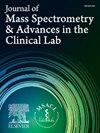Sex-based estimation of biological variation in plasma-free amino acid concentrations among healthy adults
IF 3.4
4区 医学
Q2 MEDICAL LABORATORY TECHNOLOGY
Journal of Mass Spectrometry and Advances in the Clinical Lab
Pub Date : 2025-04-30
DOI:10.1016/j.jmsacl.2025.04.010
引用次数: 0
Abstract
Introduction
Free amino acid (FAA) analysis plays a crucial role in diagnosing and monitoring inborn errors of metabolism, assessing nutritional status, and identifying metabolic imbalances associated with various diseases. This study aimed to provide updated biological variation (BV) data to support the reliable clinical application of FAA concentrations in plasma samples, utilizing LC-MS/MS.
Materials and methods
Venous blood was collected from 22 healthy Turkish adults (9 men and 13 women) over approximately nine weeks. Plasma FAAs were measured in duplicate. BV estimates with 95 % confidence intervals were determined using nested ANOVA for the entire study group and sex-stratified subgroups, following analysis of outliers, normality, steady-state conditions, and variance homogeneity.
Results
Within-subject variation (CVI) and between-subject variation (CVG) estimates ranged from 9.5 % to 32.5 % and 8.6 % to 50.0 %, respectively. The estimated CVI values for essential amino acids were significantly lower than those for non-essential amino acids (P = 0.03). For most plasma FAAs, no significant differences in CVI (except for alanine, arginine, glutamic acid, and threonine) or CVG were observed between sexes. However, differences in the indices of individuality were noted between men and women for some plasma FAAs.
Conclusions
This Biological Variation Data Critical Appraisal Checklist-compliant study provides the first updated BV data for plasma FAAs. The significant variation observed in CVI estimates is hypothesized to result from differences in the metabolic regulation of essential versus non-essential amino acids. The sex-stratified indices obtained in this study will aid in the appropriate application of population-based reference intervals for plasma FAA assessment.

健康成人血浆游离氨基酸浓度生物学变异的性别估计
游离氨基酸(FAA)分析在诊断和监测先天性代谢错误、评估营养状况和识别与各种疾病相关的代谢失衡方面起着至关重要的作用。本研究旨在利用LC-MS/MS提供最新的生物变异(BV)数据,为血浆样品中FAA浓度的可靠临床应用提供支持。材料和方法在大约9周的时间内采集22名健康土耳其成年人(9名男性和13名女性)的静脉血。血浆FAAs一式两份测定。在分析了异常值、正态性、稳态条件和方差齐性之后,对整个研究组和按性别分层的亚组使用嵌套方差分析确定了95%置信区间的BV估计值。结果受试者内变异(CVI)和受试者间变异(CVG)估计值分别为9.5% ~ 32.5%和8.6% ~ 50.0%。必需氨基酸的CVI估计值显著低于非必需氨基酸(P = 0.03)。对于大多数血浆FAAs, CVI(除了丙氨酸、精氨酸、谷氨酸和苏氨酸)或CVG在两性之间没有显著差异。然而,在一些血浆FAAs中,男性和女性的个性指标存在差异。结论本研究符合生物变异数据关键评估清单,首次提供了血浆FAAs的最新BV数据。在CVI估计中观察到的显著差异被假设为必需氨基酸与非必需氨基酸代谢调节的差异。本研究中获得的性别分层指数将有助于适当应用基于人群的血浆FAA评估参考区间。
本文章由计算机程序翻译,如有差异,请以英文原文为准。
求助全文
约1分钟内获得全文
求助全文
来源期刊

Journal of Mass Spectrometry and Advances in the Clinical Lab
Health Professions-Medical Laboratory Technology
CiteScore
4.30
自引率
18.20%
发文量
41
审稿时长
81 days
 求助内容:
求助内容: 应助结果提醒方式:
应助结果提醒方式:


